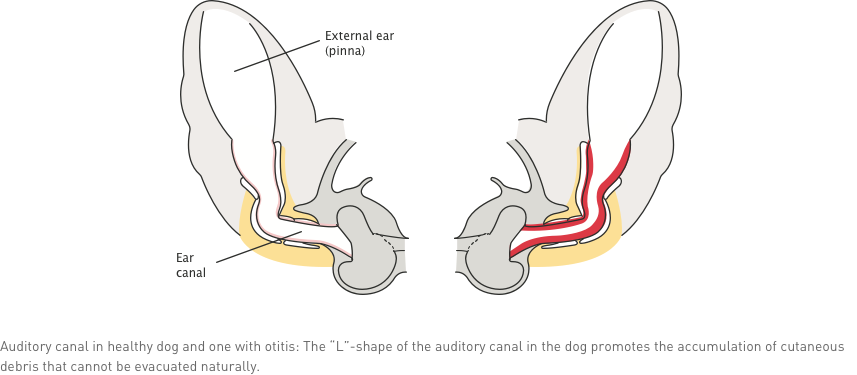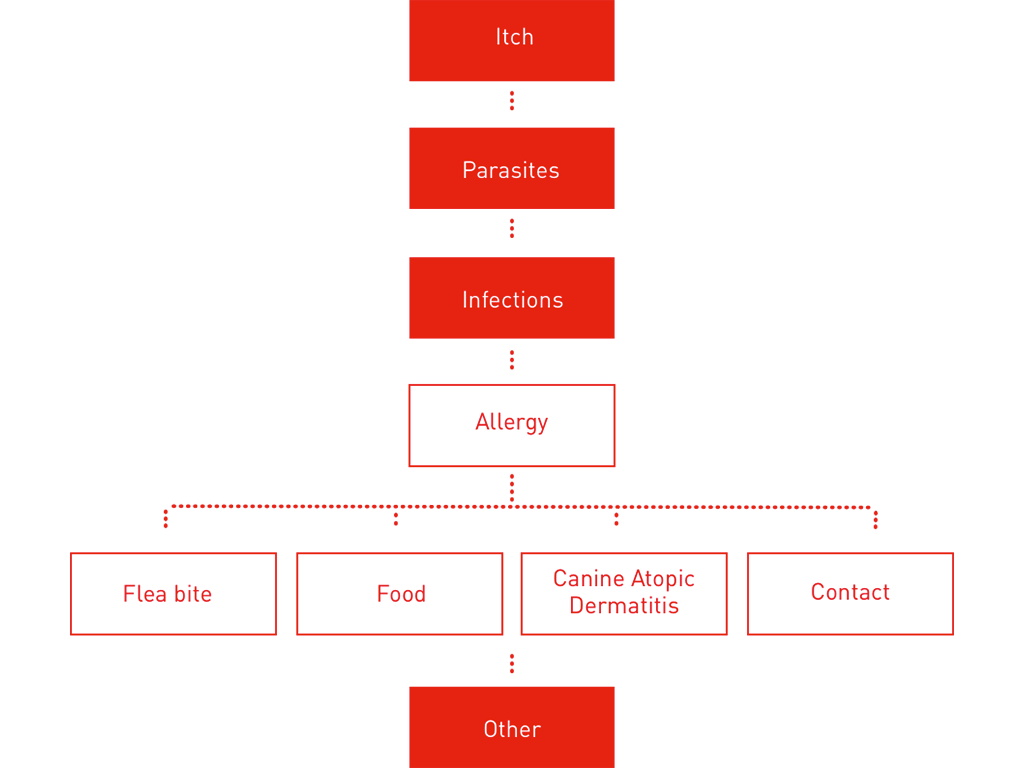Let’s talk about skin conditions in dogs

What are the symptoms of skin conditions in dogs?
Here are some clues that your dog might suffer from a skin condition.
Behaviour: Your dog scratches more than usual, shakes their head and persistently licks their fur or even bites themselves in between fingers.
Skin: Their skin appears dry, irritated, red or swollen, has lesions or open wounds.
Coat: Your dog’s coat has patches without hair, is greasy, dry, or has dandruff.
Smell: Smelly skin, ears, or wounds.
What causes skin problems in dogs?
Although specific breeds and some dogs with hereditary predispositions are more prone to skin conditions, they are not the only ones at risk.
Dogs who spend time outdoors can develop skin conditions as they can come into contact with:
- Mites, pollens
- Parasites such as fleas and ticks
- Irritating agents
- Other pets (who can carry and transfer diseases to your dog)
- Soil (which can be the home of fungus responsible for skin problems).
Reporting the symptoms and answering these 3 questions that you vet can ask you, among others, will help you find out the cause of your dog skin problems.
- Are there digestive concomitant signs as well?
- Are there other pets affected in your home?
- Is it seasonal?
1.All over the body
2.Ears
11 common dog skin conditions
Skin diseases caused by external parasites
Fleas, lice, ticks, sand flies, mites, and other parasites can infest your pet, feed on them, and be the answer to the question: What causes dog skin problems? Their bites or even just contact can lead to allergies, infected wounds, and systemic infections. If you live in an area known for parasites, regular coat checks, vaccinations and other preventive treatments are essential to help you protect your dog. Ask your vet as they are a key player in your dog’s health.
Knowing your enemies makes it easier to get rid of them, so let’s have a closer look at some of them!

Skin diseases caused by infectious agents
Your dog’s skin is inhabited by a variety of microorganisms which normally live happily together. However, parasites, allergies, or trauma for instance can disturb that fragile equilibrium and cause infectious dermatitis. Other factors such as temperature, humidity, and skin structure can also affect the microenvironment of your dog’s skin.
Bacterial skin diseases
In normal conditions, bacteria living on your dog don’t cause any harm; balanced ‘microbiome” can even be quite beneficial. However, bacterial skin diseases called ‘pyoderma’ are common in dogs. If your vet suspects your dog has a bacterial skin disease, they may perform some tests to confirm that bacteria are the root cause and to determine the microbe responsible for the condition. Topical treatments such as lotions or shampoos are often used to treat bacterial infections. In some more cases, oral and/or long-term treatments recommended by your vet may be necessary.
Viral skin diseases
Viral skin diseases are rare in dogs. The most common is a form of wart known as ‘papillomatosis’. The disease can regress spontaneously. However, some dogs have persistent masses, and surgical removal is generally required when it alters the dog’s quality of life (eg by bleeding frequently).
The most dangerous one is called ‘Hard pad disease’ (distemper disease). It causes a thickening of the paws and nose of your dog among other symptoms that are not skin-related. It can be fatal but is preventable with vaccinations. Better safe than sorry. If you’ve noticed any of the symptoms described here, check with your vet.
Fungal skin diseases
Ringworm (‘scientifically aka dermatophytosis’’) aren’t caused by a worm but are a fungal skin disease. The fungi feed on keratin, the main component of dog’s hair, and can cause nails, skin and coat diseases. Symptoms include extensive hair loss, scales, broken hairs, or inflammation of the hair follicle or the skin. Ringworm is highly contagious and may also spread between dogs and humans, treatment must be thorough and global to manage both your pet and the environment. Your vet will recommend the best options!
Skin diseases caused by yeast
Yeast is normally present in a dog’s skin but in some conditions, it becomes pathogenic and creates dermatitis. Also called Malassezia yeast, it can affect the ears, face, neck, or feet but can also be generalised. If you notice that your dog’s skin smells bad, looks inflamed, looks darker and thickened and the itching is constant, your dog might be suffering from a yeast infection.
These infections can also be very smelly (think cheese). The management may require topical and systemic products but finding any potential underlying issue such as environmental allergy may be very important too to prevent recurrency.
Ear conditions
Yes, you heard right. Ear problems in dogs are skin conditions.
Ear problems can be caused by bacteria, parasites, yeasts, allergic otitis but also foreign bodies such as grass or insects getting stuck in the ear canal inducing otitis. If you see your dog violently shaking or poking their head with their paw, it’s possible they have an ear condition and it’s important to check with the vet, especially during the season where spikelets area abundant as these can migrate down the ear canal and do not come back up, even until the perforation of the tympanic membrane.

Legend: Auditory canal in healthy dog and one with otitis: The “L”-shape of the auditory canal in the dog promotes the accumulation of cutaneous debris that cannot be evacuated naturally.
Itchy skin conditions
The 'itchy dog condition’ also known by scientists as ‘pruritus’ creates the odd itch, a common sign of many dogs’ skin disorders. Insistent scratching is the first sign of the condition, red, inflamed skin and hair loss, classical scratching with hands & feet nails, or biting in between fingers, excessive licking often add to the full picture. Itch can have many causes, reason why it’s important to investigate them to confirm the precise reason behind and get the adapted treatment. Your vet can determine what is causing your dog’s pruritus to manage it as best as possible. If your dog keeps scratching this article can help you find out why.
Allergic skin conditions
Skin allergic dermatoses can be caused by your dog’s environment, food, or by flea bites and can make your dog’s skin appear dry or red. Itch is very frequent and digestive signs such as diarrhea can also be present. There are lots of things your dog could be allergic to, and they all have the potential of impacting your dog’s quality of life significantly, even though some are mostly seasonal. This article will help you better understand dog skin allergies.
Allergic skin conditions specifically triggered by food
Some dogs are sensitive or allergic to certain foods and skin lesions can appear after their meal. If they suspect it’s the case, your vet may put your dog on an elimination diet to identify which foods sets your dog’s skin on fire. If your dog has sensitive skin, talk to your vet about diets designed for their condition.
Allergic skin conditions specifically triggered by environmental allergens: Canine Atopic Dermatitis
Canine Atopic Dermatitis (CAD) causes pruritic inflammations. Skin redness or lesions can be found around the face, joints, and perineal area where the skin overreacts to stressors such as pollens, mites, or moulds. CAD is one of the most common skin conditions in dogs, but it's not the only one. If you notice redness, swelling, dandruff, or hair loss, contact your vet for a professional diagnosis. This article will help you better understand how you can recognize your dog’s Canine Atopic Dermatitis.
Which skin condition does my dog have?
Skin problems can also be a sign that something more serious is going on with your dog’s health. Getting the correct diagnosis is crucial, the sooner you know what your pet is suffering from the better. If you notice skin lesions, smell bad, scratching happens more often than usual or you notice hair loss, it’s time to turn to the health expert. From dermatological examinations to skin allergy tests, microscopic observations, or recommending diet plans, your dog is in good hands with your vet.

What are the treatments for dog skin conditions?
Treatments can vary from topical lotions to oral drugs, injections, desensitization, and surgery depending on the cause and severity, but there are steps you can take to help prevent your dog developing skin problems. Keeping their vaccinations up to date, choosing an appropriate food with a targeted mix of nutrients with the help of your vet, being aware of external factors, and following a skin care routine are some of the actions you can take to support your dog’s skin and hair health.
Like & share this page